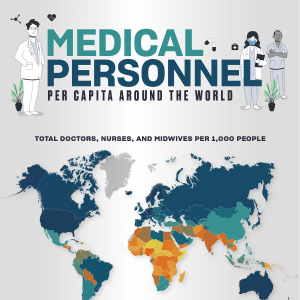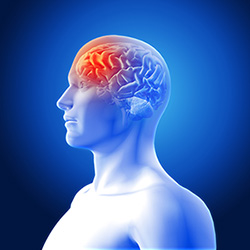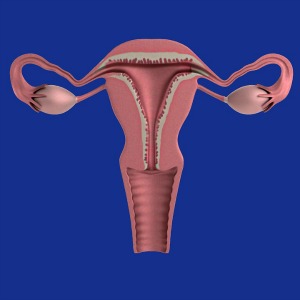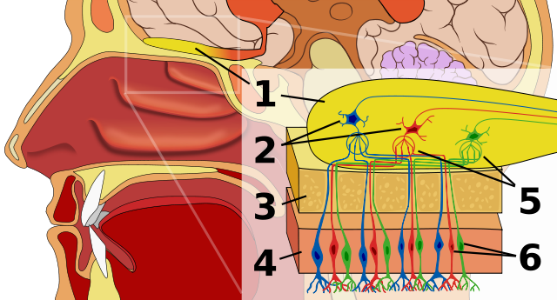Category - medicine
Posted by Julia Tortorice
Medical professionals like doctors and nurses are essential to public health around the world. They are a crucial part of preventative care and can also save lives in emergency situations. Specialized medical personnel can also treat more specific issues like cancer, mental illnesses, and heart disease.
The NYRequirements.com team looked at data provided by the World Bank to see which countries around the planet have the most physicians, nurses, and midwives per 1,000 people. Take a look to see which country came out on top!
Click here to download the printable PDF version of the chart.
Countries With the Most Medical Personnel per Capita
Based on the most recent data from the World Bank, these are the countries that have the most physicians per 1,000 residents:
Cuba: 8.4
Monaco: 7.5
Georgia: 7.1
Greece: 6.3
San Marino: 6.1
Portugal: 5.5
Austria: 5.3
Norway: 4.9
Uruguay: 4.9
Finland: 4.6
Lithuania: 4.6
The country with the ...
Posted by Emily Pazel
If you live with some form of back pain, whether it’s from an injury or slowly developed over time, you are not alone. According to the World Health Organization, roughly 60% to 70% of people living in industrialized countries around the world suffer from lower back pain; and, to no surprise, it is the leading cause of “activity limitation and work absence throughout much of the world.”
If you have personally dealt with back pain in your life, there’s a high chance that you visited a Chiropractor. A Chiropractor, according to Spine-health.com, is a healthcare professional that focuses on the “diagnosis and treatment of neuromuscular disorder.” And, more specifically, treatment is done through “manual adjustment and/or manipulation of the spine.”
When you make a visit to the Chiropractor, especially if it’s your first time, you may want to be sure you research and read carefully what to expect at your visit. Generally, chiropra...
Posted by Emily Pazel
Before vaccines were created, the reality of severe illness – or even death – from widespread diseases was a worldwide fear.
Overtime, vaccines have successfully evolved in the healthcare industry, eradicating certain diseases altogether, such as smallpox, and nearly eliminating others, like polio. Other diseases such as measles, diphtheria and whooping cough are at an all-time low, according the Center for Disease Control & Prevention (CDC).
When a child is born, they are born with protection against some diseases due to the mother passing antibodies to them in the womb and through breastfeeding. However, this protection is temporary, and as such, children are recommended to receive certain vaccinations at varying stages of their lives.
Protecting your child’s health plays a vital role in parenthood. Before making the decision to vaccinate your child, do some research on these topics:
How vaccines work
Types of vaccines & its ingre...
Posted by Sandy Thompson
Migraines are not just bad headaches, they are a neurological disease. More than 38 million people suffer from migraines in the United States. With the development of new preventative medication, migraine susceptible patients now have renewed hope.
What exactly is a migraine?
As stated by the Migraine Research Foundation, “Previously, the dilation and constriction of blood vessels in the head were thought to be the primary source of migraine pain, and early medications focused on the blood vessels as the principal target for treatment. Researchers now believe that migraine is a neurological disorder involving nerve pathways and brain chemicals”.
Neurological disorders affect the nervous system, which includes the brain and pain fibers from the tissues surrounding the brain. Migraines disrupt the way the brain processes pain, light, sound, and smell.
The cause of migraines are still unknown. Currently, there are no tests that can diagnose migraines, but medical p...
Posted by Katrina Poggio
The National Cancer Institute at the National Institutes of Health estimates that more than 252,700 women will be diagnosed with breast cancer in just this year alone.
Of those affected, about 40,600 people will die of the disease, but a new drug may help bring those numbers down and give a fighting chance to those battling the most common form of cancer in the U.S.
The Food and Drug Administration approved AstraZeneca’s Lynparza, on January 12, 2018 to help treat those impacted by breast cancer.
It is the first time ever that a drug has been approved to help treat patients with metastatic breast cancer who also have a BRCA gene mutation, according to an FDA press release.
“This class of drugs has been used to treat advanced, BRCA-mutated ovarian cancer and has now shown efficacy in treating certain types of BRCA-mutated breast cancer,” said Richard Pazdur, M.D., director of the FDA’s Oncology Center of Excellence and acting director of the Off...
Posted by Sandy Thompson
The number of important medical discoveries at Harvard Medical School since the 1970s has more than quadrupled when compared to the previous 150 years. The pace of medical technology advancement clips along quite rapidly. Here are nine recent or pending discoveries and what they mean for the future of medicine.
1. 3D Medical Imaging
It’s no secret that the medical community faces a shortage of physicians, sometimes due to the intense, difficult nature of medical school. 3D4Medical hopes to make the medical school experience more practical and possible with 3D recordings of moving muscles, tissue and organs to help students see in a less-theoretical model of how different systems of the body actually work through a suite of apps. EchoPixel is another 3D platform that takes a patient’s anatomy from various already-existing scanning methods (i.e., MRI, X-ray), renders it in an augmented reality format viewable with special glasses, and makes it accessible for medical pro...
Posted by Sandy Thompson
Chances are you or someone you know has been prescribed opioids. Opioids are any number of substances, legal or otherwise, used to alleviate moderate to severe pain. If you’ve ever incurred a serious injury or are recovering from surgery, your doctor more than likely handed you a prescription for this medicine with a specific set of guidelines on when and how to take them.
When used properly, opioids are an effective and generally safe method for short-term management of more serious types of pain—they reduce suffering and invoke a level of sedation to help patients keep their minds off the pain.
Recently, though, opioids have become much more accessible to patients, and it has been found that long-term use can have some dangerously dire repercussions, including addiction, overdose, and death. In fact, as of 2016, it has been found that half of Americans know someone who is addicted to opioids. And that’s just prescription painkillers; outside of the doctor&rsq...
Posted by Kristal Roberts
What if a drug was flexible enough to reach the site of a wound or illness, give relief when necessary, stop releasing medicine when pain is gone, and start releasing it again if an illness progresses or discomfort re emerges? Well, it’s here, and this gel substance, a hydrogel likened to Jello, is showing a lot of promise.
Researchers at the Laboratory for Accelerated Medical Innovation at the Brigham and Women’s Hospital developed the substance and it works by being drawn to inflammations sites in the body. The gel senses inflammation and slowly delivers medicine to fight ailments such as arthritis, ulcerative colitis and mucositis, for example.
The beauty about the gel is it can be injected directly the site of pain and it responds to the level of inflammation around it, delivering the appropriate dosage. So if an arthritic patient gets injected with this gel, the medication will activate only in response to the site causing an episode, pain or swelling...
Posted by Kristal Roberts
As antibiotic resistance continues to become a growing problem for public health, new research finds that that may be a taller task than health officials originally thought.
A recent study found that as much as 30 percent of all antibiotics were prescribed unnecessarily in physician offices and clinics.
It was discovered that patients were are often prescribed antibiotics for mild health issues in cases where it was clearly unnecessary.
For example, some patients were prescribed antibiotics for the common cold, which is a virus that can be treated differently.
More than 184,000 patient visits to doctors and clinics in 2010 and 2011 were reviewed for the study. It was determined that for 506 prescriptions written for every 1,000 people, 353 were appropriate. In sum, that's an estimated 47 million prescriptions each year that are unnecessarily prescribed.
However, the reason, in part, for this is attributed to physicians feeling that patients expect t...
Posted by Kristal Roberts
We all know what healthcare is supposed to be about --- saving lives and treating people.
So it can be a real rude awakening to hear that medical errors are being reported as the third highest cause of death in the United States, according to research at Johns Hopkins University.
The study, which was led by Johns Hopkins surgeon Dr. Martin Makary, found that over 250,000 people die from medical errors each year. That follows just behind heart disease and cancer, which claim about 600,000 lives collectively.
How does this happen?
Well, it’s not a complete mystery to those of us who are in the industry like nurses, doctors and everyone else who gets an upclose view to the chaos can ensue behind the scenes.
Healthcare professionals aren’t infallible; anything from mixed up dosages and incorrect medication to surgical complications can happen more often than some are willing to admit.
The thing is, it’s very difficult to get the precise impact of medical...
Posted by Kristal Roberts
Some years ago, a surgery like this may not have even been conceivable, but the first uterus transplant in the U.S. has been successfully completed at the Cleveland hospital.
A 26-year-old woman underwent a nine-hour surgery toward the end of February and she is in stable condition, the New York Times reports. No further details have been released about this patient, but she provides a beacon of hope for countless women.
This surgery is a life changing advancement for women who are born without a uterus or women who had theirs removed under different circumstances.
There are about 50,000 U.S. women who are considered to be transplant uterus candidates.
Having this surgery available means they may be able to become pregnant and have children.
The way the procedure works is surgeons must remove a uterus and the small uterine vessels from a female organ donor who recently died.
The uterus can survive for up to eight hours if it’s kept cold.
The surgeon then conn...
Posted by Kristal Roberts
The world of 3D printing has given us a lot of different things, from toys to replicas of organs, but the industry has officially ventured into a new frontier of medicine.
The Food and Drug Administration has approved the nation’s first 3D Printed prescription drug.
Spritam, developed by Aprecia Pharmaceuticals, is a dissolvable tablet that will be used to treat epilepsy children and adults suffering from seizures. They've patented their use of 3D Printing as a process called Zipdose, which allows for more drugs to be put into each tablet.
Chemist Lee Cronin, a professor at the University of Glasgow, likened the process of designing 3D medicine to following a dinner recipe during a 2012 TedGlobal talk, the Washington Post reported.
“Imagine your printer like a refrigerator that is full of all the ingredients you might require to make any dish in Jamie Oliver's new book,” he said.
Cronin said the cook book approach is applicable to...
Posted by Kristal Roberts
If you think Tylenol, Advil and all the other over-the-counter painkillers are one and the same, you couldn’t be more wrong, according to a recent report from the Wall Street Journal.
While they’re all generally used for different types of discomfort in the body, certain brands work best for particular ailments, based on their active ingredients.
For example, if you have a headache,Tylenol and other brands with acetaminophen are considered your best bets, because it has less side effects.
If you’re suffering from an injury or tough pain like arthritis, menstrual cramps or a toothache, Advil and other medications with ibuprofen as the active ingredient are the better options, thanks to ibuprofen’s anti-inflammatory properties.
How Do They Work?
The medical community doesn’t have all the answers regarding the impact of acetaminophen on the body, but experts believe the drug blocks pain receptors in the brain. Ibuprofen and other meds in the NS...
Posted by Kristal Roberts
Is one of your new year’s resolutions to be a better nurse to your patient? Whether you planned on improving your nurse-patient relations or this article was the first time you’ve thought about that in a while, there are some simple improvements you can make in your day-to-day interactions with patients that won’t require additional continuing education courses or any major effort on your part--just a few tweaks in your approach.
This doesn’t mean that you don’t already incorporate good practices, but sometimes, it’s easy to get jaded and look at your patients as just another body in your hospital.
Here are a few tips to humanize your patients, have them feel better about their experience at your facility, and have you feel better about yourself.
Basics – Know Their Names, + 1 Factoid
This may be really obvious to some, but it’s easy to forget little patient details when you’re caught up in the hustle and bustle of dia...
Posted by Kristal Roberts
The spinal cord is responsible for communication between the brain and the central nervous system, which is the command center for our body’s actions. It’s what allows us to pick up a toothbrush and apply some toothpaste when we think, “time to brush our teeth”.
It’s what allows us to roll our eyes when a patient (or doctor) says something idiotic. That’s why damage to the spinal cord often results in paralysis much like the case of Derek Fidyka, a man who became paralyzed and lost sensation from the chest down after getting stabbed in the back repeatedly in 2010. The attack left him with a seven millimeter gap in his spinal cord.
While spinal cord damage is generally believed to be permanent for the two to three million who suffer from it world-wide, 40-year-old Fidyka is now walking again, thanks to a first-of-its-kind procedure that used “nose” cells to repair spinal cord injuries.
The olfactory system, which controls our sens...
Posted by Kristal Roberts
What if a band-aid not only covered a wound, but stopped the bleeding and accelerated the healing process in mere seconds?
Well that technology is here and could possibly be available in a store near you, in the distant future.
It’s called VetiGel, a flexible polymer gel that is applied to or injected into a wound and begins the process of clotting to stop bleeding. Essentially, it could stop traumatic bleeding immediately.
Toted as the band-aid of the future, VetiGel was created by Joe Landolina, the CEO and co-founder the New York based biotech company Suneris.
Landolina got the idea to use a polymer as a way to seal up a wound as a freshman at New York University. He had no idea that it would work so well.
The polymer is made from material extracted from the cells of plants. When it’s applied to wounds, it works like Lego blocks, building off of what’s already there. It changes shape and color, “interacting with the wound in a way t...
Posted by Julia Tortorice
Scientists have implanted a lab-grown vagina in humans, a medical first.
The patients, four teenaged girls, donated their own tissue to be used for the development of the vagina.
These girls suffer from Mayer-Rokitansky-Kuster-Hauser (MRKH) syndrome.
The vaginas were implanted in June 2005 and October 2008.
Their yearly follow-up visits concluded that the implants were a success with the lab-grown organs functioning normally, even during sex. Their tissue was acting just like the original tissue.
This study gives hope to patients who need vaginal reconstructive surgeries. It also helps establish the benefits of regenerative medicine strategies when used on human organs and tissues.
However, the operation is still waiting for FDA approval. Once it is rendered safe, it can even be used on men who looking for a sex change.
The pilot operation was conducted by specialists from the US and Mexico. A biopsy was done on the patients’ vagina. Cells from th...
Posted by Norlyn Golez
Antibiotics improve the height and weight of children on the brink of undernourishment in developing countries.
This is according to the research team at McGill University. They reviewed research literature to examine whether antibiotics have a significant impact on the development of the youngest children from countries with low to middle income class. The paper was published in the British Medical Journal.
Antibiotics did not have any significant effect on the growth of children from the countries of Malawi, Guatemala, Brazil, and Zambia.
But the McGill team wanted to determine if antibiotics have any effect on the development of pre-pubertal children in developing countries. They examined the changes in both the weight and height of the children by looking into the research literature about studies conducted on the treatment of one-month to 12-year old children in seven developing countries. These were children who are smaller both in terms of weight and height when compare...
Posted by Norlyn Golez
Small peptides kill bacteria in various ways, possibly making it the newest class of antibiotics. This is based on the research conducted by Ruhr-Universitat Bochum (RUB) biologists.
The researchers said that in about a decade, bacteria would have developed resistance against current antibiotics, rendering them ineffective and useless. But according to their study on M196 peptides, which was chosen as the representative of very small peptides that are made of four to as many as 10 amino acids, these peptides were found to be efficient in eliminating bacteria. They are especially effective against multi-resistant pathogens that trigger sepsis.
Earlier studies have proven this, but the group was focused on finding out just how the peptides are able to do it. Only then will this potential antibiotic has a shot at being approved as a new drug, like how it is with other new substances developed to treat certain diseases.
The study finally showed that the peptides attach themselves ...



















